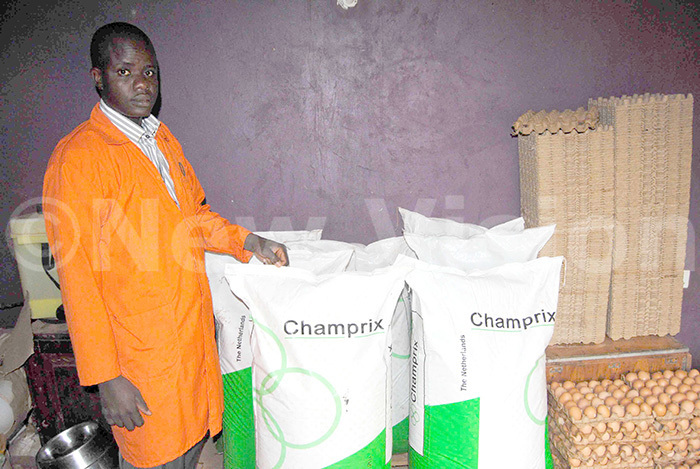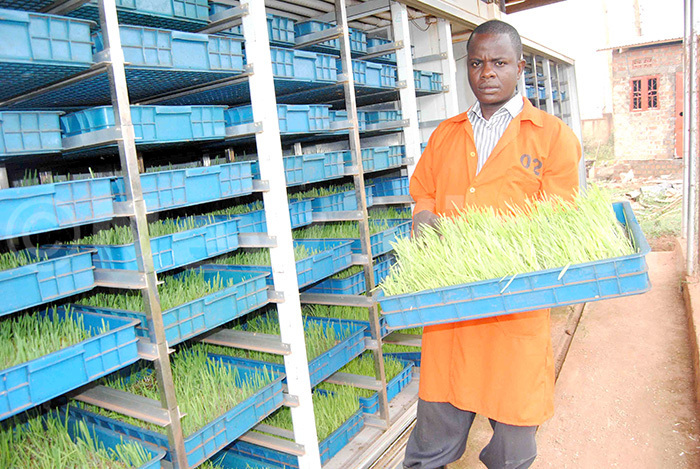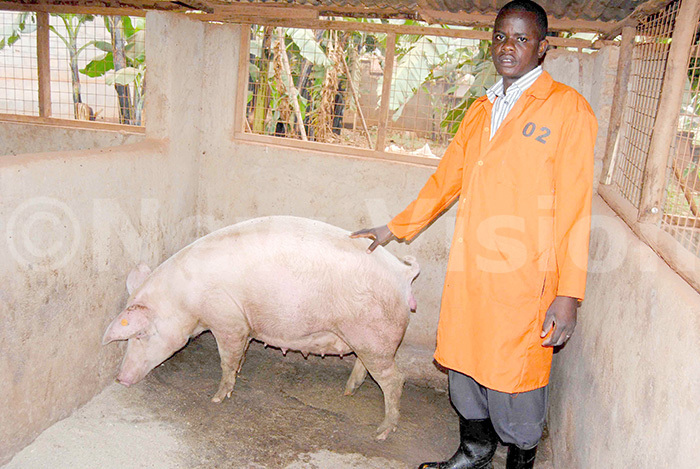Good chicken management improves Sserwanga's profits
Yellow yolk eggs have better and more reliable market in the poultry industry than the plain ones.
By Herbert Musoke
When he opens the chicken house, you are welcomed by the sight of hundreds of brown layers, sitting in rows and rows of cages. While these look like any other layers, the owner of this farm, Geoffrey Sserwanga, has a secret from them! These layers produce only yellow Yolk eggs.
Yellow yolk eggs have better and more reliable market in the poultry industry than the plain ones. This is what Sserwanga, the director of Kisakyamukama mixed farm at Gangu along Busaabala road, decided to exploit in order to create a distinct market.
"When I joined this business, I knew that there are so many other players, doing the same things so I decided to provide yellow yolk hybrid eggs," he says.
According to Sserwanga, the farm has over 2,000 layer chicken, piggery and diary. He says the poultry industry is very competitive in Uganda given the fact that many people think it is simple to engage in. This, therefore, calls for innovativeness and investments to create uniqueness.
To ensure that his chicken produced yellow yolk eggs, Sserwanga invested in a hydroponic fodder made using barley seeds, that he feeds his layers to give him yellow yolk eggs that he says sells highly compared to those who use ordinary feeds.

PIC: Sserwanga showing the eggs he collects from the poultry unit
How he started
Sserwanga says the farm started with broiler chicken in 2008 for about three years, before he shifted to layers until 2011. At the beginning, he kept between 1,000 to 1,500 layers. "I would keep them for two months, then sell them off," he says.
But there was one big challenge for him, just like it was for other poultry farmers. Feeds prices! When the key feeds ingredient like maize brand, silver fish and cotton seed cake among others became very expensive and unreliable.
"The quality of the feeds was never stable because today you could get better quality feeds and the next day very poor quality feeds. Because of this we decided to suspend the farm in 2014 until 2016 when we were advised to start using feed concentrates as part of the feeds formula. I got my concentrates from Champrix Feeds Company, of the Netherlands," he explains.
He says that since they started using feed concentrate premix, they have benefited a lot because the nutrition content is constant and this gives the farmer what they exactly want.

PIC: Geoffrey Sserwanga the manager Kisakyamukama Mixed farm-Busaabala showing the premix used in the layers' feeds. (Credit: Herbert Musoke)
Sserwanga says at the beginning, they started with deep litter system but it was so challenging since the chicken would eat the eggs, have more disease outbreaks because it was difficult to clean, waste of feeds and water among others. A deep litter system is when the chicken is kept on the ground. It may be cemented or not, but covered with soft material for example wood shavings.
Investing in cages
Facts about the chicken cage system.
-It is a ‘self- contained' structure that fits in the smallest of spaces, hence good for backyard farming.
-Chicken have less exercises because of limited space. Some say, this affects their physical development.
-You can either have one cage for 150-208 chicken, or several combined cages depending on how many chicken you are keeping.
-Keeps chicken in a limited area. Hence making it easy for the owner to supervise them and monitor their numbers.
Sserwanga says after that experience, they opted for a cage system later in 2016. It cost him over sh15m to buy the cages and installing them. The cages were bought from a local company that imports them from Israel.
According to him, cages seem expensive but the benefits you get from the system pays you off to the last penny. For example you maximize the feeds, water, avoid diseases, and improve sanitation, bird's security among others.
"The current stock is now over one year old, but the average percentage at which they are laying is between 90% and 93% yet with the deep litter system we got 80% for about two weeks before they went down to 70%. Their usual percentage was 60%," he explains. To put it clearly, this means that out of every 100 layers under a deep litter system, 60 lay eggs everyday compared to 80 under a cage system.
To Sserwanga, the cost of the cage can be recovered though the quality and quantity of eggs you get from your farm. "For now we get 55 trays of eggs daily that we sell at sh9,000 to wholesalers and sh9,500 to retailers.
Sserwanga also says that the cage system further improved security of his farm. "Since each cage carries a known number of chicken, workers cannot steal them because it will be easy for the owner to find out that some chicken are missing," he says.

The fodder Sserwanga feeds the chicken on to get the yellow yolk eggs
Feeding and water
Sserwanga explains that they mix their own feed at the farm. "The ratios differ from stage to stage but now we mix 1.7 tonnes with 7 bags of premix with each bag weighing 50kg that cost sh200,000 a bag. This gives us the best feeds for our chicken thus giving us a high laying rate," he says.
He says they supplement the feeds using hydroponic fodder grass that they make using a hydroponic system. "We feed our chicken four times a day; that is at 8:00am, noon, 2:00 and in the late hours we feed them on grass. This gives them the ingredient that makes the yellow York," he explains.
For water, Sserwanga has an underground well, from which they pump water to the tanks. Because they use cage system, the water flows by gravity through the pipes. "We have smaller tanks that we use when we are to give medication to the chicken to avoid wastage," he says.
Market
Sserwanga says that because he has yellow York, his eggs have high demand. "Although at times the market for eggs drop, we are not affected because we have already market for the eggs and buyers pick them right from the farm gate," he explains.
Piggery and diary
On less than an acre, Ssewanga currently the farm has five comborough sows and one Friesian cow. "Our plan is to have thousands of pigs where we can slaughter over 50 pigs weekly", he explains.
As many would think of selling milk from cow, Sserwanga's plans are to feed the piglets with this milk to supplement on their mothers' milk to help them grow more health and strong.
Earnings/Book keeping
All the farm books of account system are computerized where every transaction that transpires at the farm is documented.
At the moment, most of the earnings come from the eggs. At a production of 80% from his 2,000 layers, he gets 55 trays every day. At the moment, each tray goes for sh9,500, which is a gross of around sh522,500 per day or sh15.6m per month. From this money, he spends around sh12m for buying feeds for the animals-including concentrates and paying his workers.
Community benefit
Sserwanga says that they have trained community members who wish to join poultry and others who are already into poultry but not doing well.
"Although we have gotten many members especially from around the here, whoever comes with intention to be advised in any way, we help them and we have seen many of them transform their farms," he adds.
Waste management
Many urban poultry farmers have a challenge with waste management. For Sserwanga, they use the chicken droppings as fertilizer for the small banana plantation. The plantation sits on around a quarter of an acre and the food is largely for home consumption.
"The waste has now accumulated and we have started training in how to use this waste to make feeds for the pigs. This will go a long way to enhance the piggery productivity as well as promoting sanitation at the farm," he adds.

Sserwanga also has a piggery unit on his farm
Challenges
Sserwanga says that the fact that quality concentrates can only be imported from Netherlands or other countries affects the planning of a proper feeding schedule. "The challenge now is that we may not have the concentrates sometimes and yet the chicken are used. We try to solve this by making new orders long before we run out of stock," he says.
Before he went for the cage system, poultry diseases were very common on his farm. "The cage system, plus our bio-security system have since reduced the occurrence of diseases on the farm," he says.
Future plans
Sserwanga explains that, Gangu is developing into a modern city each day that passes. Therefore they have plans of buying a bigger land where they can establish a modern farm.
He says they have plans of having 10,000 birds, slaughtering over 50 pigs a month. "This will make our farm more competitive and profitable".
Who is Sserwanga?
He is a P7 dropout, but has managed to go this far because of passion and he has acquired all the knowledge and skills from the trainings and seminars he attends.
"Being a great farmer doesn't require one to have degrees, it is all about passion, commitment and being attentive to what the trainers tell you. It is because I follow what the trained have been telling me, that I have developed this farm, this far," he explains.
WHAT OTHERS SAY:
Musa Ssebunya, a resident of Gangu
I did not know much about chicken cages however after Sserwanga got them here, I realized that it is a good technology for those engaged in keeping layers. It is easy to monitor the feeding and health of the birds and easy to count the eggs.
Zuraika Namwanje, a resident of Gangu
Sserwanga's experience has showed us that if poultry are properly managed, they pay back. Farmers should stop feeding the birds using rudimentary methods because at the end of the day, they will yield less.